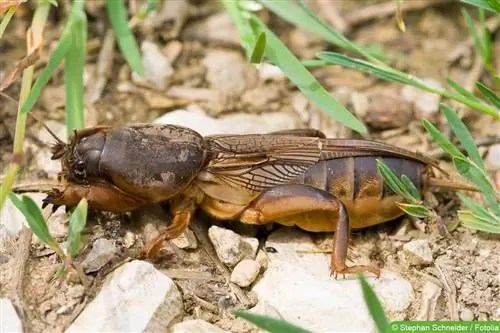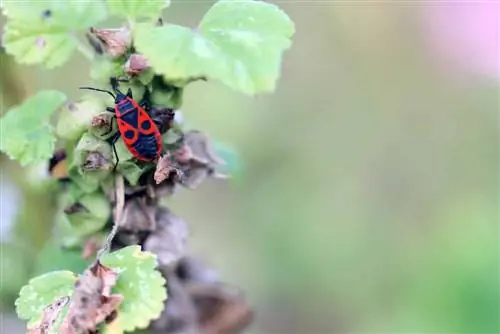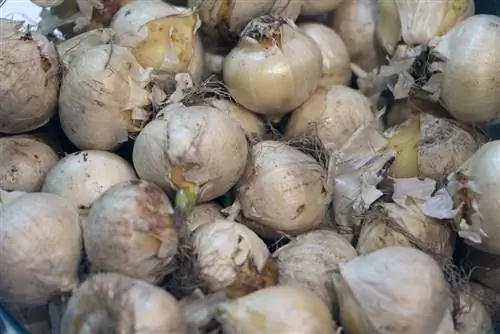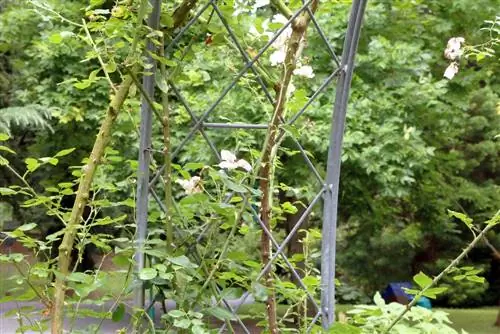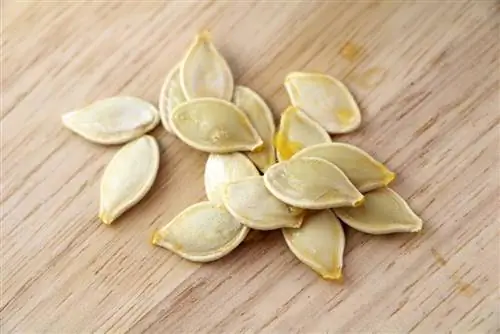- Author admin [email protected].
- Public 2023-12-17 03:39.
- Last modified 2025-01-24 12:45.
The mole cricket is considered endangered and, like the field cricket, rarely causes damage to plants. Instead, it is a beneficial insect as long as there is enough other food available.
Identifying mole crickets
Identifying the Werre is not easy because eggs, larvae and adults are found in the soil. The adult insects can also fly, but they only spend a fraction of their life above the surface of the earth. They can be recognized by the following features:
- dark brown to black coloring
- armored head
- Size up to seven centimeters
- Habitat often near bodies of water, under the lawn or in the compost
- nocturnal
- strong front legs
Tip:
Due to the similarity to the field cricket and the nocturnal activity, differentiation and recognition can often be difficult, especially for laypeople. Even the chirping is only noticeable for a short period of the year. However, this only applies if there are only a few copies available.
Damage of the mole cricket
Normally, this type of cricket is a beneficial insect, but unfortunately it is still endangered. In small numbers and with enough food, they do not cause any damage. However, if the population gets out of hand and the preferred food is no longer available in sufficient quantities, the following problems can arise:
- eaten root vegetables and tubers
- unearthed seedlings
- Hills and dug up areas on beds
- Holes and discoloration in the lawn
- Damage to plant roots
Tip:
The mole cricket is mainly found in natural gardens, but is usually not noticeable here. If there is no natural corner with tall grass and compost, problems arise more quickly and they appear early.
Food of mole crickets
Crickets usually eat animal food. For example:
- Larvae
- Insect eggs
- Maggots
- Snail eggs
- worms
If possible, these are even created as reserves in the underground passages. However, if there is not enough animal food, the crickets switch to plant roots and root vegetables. The consequences are holes in the tubers and growths appearing in seemingly inexplicable ways. This happens, for example, when the preferred food sources are overused by too many animals or when there are insufficient quantities of pests available due to pesticide control.
Spread of insects
The Mole Grill or Werre was named after its way of life. Although the insects can even swim, they live mainly in the burrows that they dig themselves. Here they find their food, build supplies and lay eggs.
These corridors and buildings have, among others, the following features:
- can reach lengths of up to 30 meters
- partially visible through holes or small mounds of earth
- Depth from five to 30 centimeters
From the outside or above, these cricket buildings are often extremely inconspicuous and difficult for laypeople to recognize.
Fighting the Werre
When mole crickets appear in large numbers, they can be a problem. Combating or at least expelling them then makes sense. This can be achieved in various ways.
Attract predators
The natural predators of the mole cricket include:
- Ants
- Chickens
- Hedgehog
- Cats
- moles
- Shrews
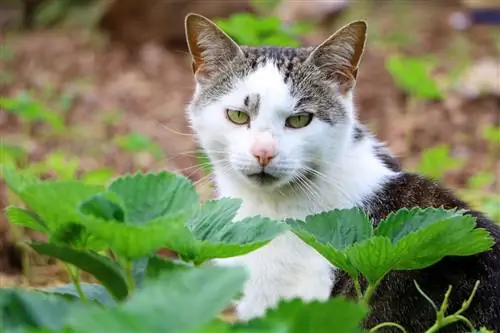
Attracting or keeping these animals is also recommended for other reasons. They are generally favorable for a balanced ratio of living creatures in the garden. Creating natural areas helps attract animals. This includes, for example:
- To make grass grow taller in a corner
- Building a pile of wood
- Create a pond
Tip:
The beneficial insects can also cause damage in the garden. However, if the fauna is in a stable balance, the animals regulate each other.
Nematodes
If there is a very severe infestation of mole crickets, the use of nematodes is recommended. These use the adult insects as hosts, penetrate them and gradually kill them. The nematodes of the Steinernema Carpocapsae species do not act against larvae and eggs, but they can significantly decimate the mole cricket population.
If they can no longer find food, they die and therefore do not pose a problem or burden. If necessary, the application of the nematodes must be repeated if more larvae hatch and grow. The nematodes or roundworms are available both in specialist shops and online.
Create traps
If the infestation is small, it is possible to introduce humane traps and then release the crickets far away. This means that the endangered animals are not further decimated, but they do not cause any damage either.
When deploying the traps, proceed as follows:
- Provide mason jars or other containers that are as deep as possible. These must have a smooth inside.
- Dig the containers deep into the ground so that the top edge is flush with the surface of the soil. The opening must of course remain free.
- It is often recommended to place a wooden stick vertically in the glass. In this way the insects should get in but not out again. However, this is often not the case. A branch or a ledge can also be used as an escape route. The insects can also fly and move upwards easily thanks to their strong and rough front legs.
Tip:
Containers that are as narrow and deep as possible are particularly suitable. This means that climbing out or flying out is no longer so easy. They should be checked early in the morning and emptied if necessary. However, this method is usually not really effective.
Destroy buildings
When the Werre has settled in its own garden, it also creates breeding holes here. These can be found by using a stick and checking the holes and passages. Tunnels that are almost vertical indicate eggs or larvae underneath.
These should be dug up with a spade and destroyed if the infestation is very severe. Alternatively, relocation to another location is possible. The compost heap, for example, is suitable.
Pesticides and home remedies
In addition to the recommended products and measures, there are also pesticides and home remedies. However, these pollute the environment and often other beneficial organisms, which means they should not be used.

